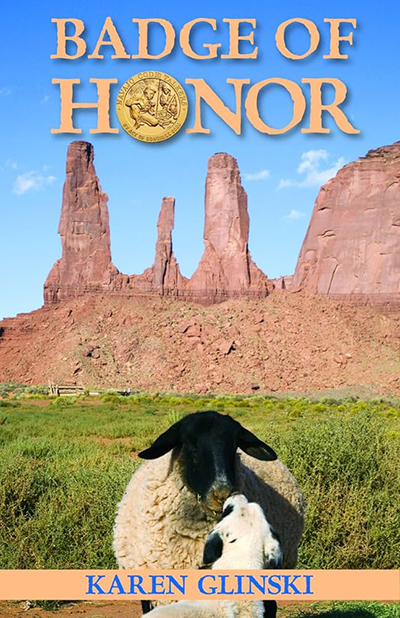 Badge of Honor
Badge of Honor
A tween boy and his dog rescue Navajo cultural treasures from a gang of thieves in Karen Glinski's lively and well-researched middle-grade novel, Badge of Honor.
In the middle school and early teen years, young people are discovering who they are outside the parent-child context. Relationships with other adult mentors therefore feature frequently in stories for this age group, from traditional orphan adventure stories to boarding-school fantasy novels. In Badge of Honor, 11-year-old protagonist Emerson is spending summer vacation with his Navajo grandfather at sheep camp in New Mexico while his mother is in nursing school and his father is in Afghanistan with the Air Force. This set-up is a gentler way to put the young main character into situations where he has to solve problems for himself, without the trauma of permanent loss.
There's plenty at stake for Emerson from the beginning, though, as Grandpa Charlie is bitten by a rattlesnake and the boy has to drive him from their remote campsite to the hospital. Sleeping over at the nurse's house while his grandfather recovers, Emerson discovers that her son is working with a gang who are stealing jewelry and war medals to fence on the black market. The medals belong to the last surviving Navajo Code Talkers, World War II heroes who created an unbreakable code for the Allies based on their indigenous languages.
Emerson and his brave little dachshund, Lucky, are soon at the center of a dangerous quest to return the treasures to their rightful owners—but Emerson himself is tempted by the loot. His adventure teaches him to appreciate the ethics and rituals of his Navajo heritage.
Glinski understands what appeals to this age group, especially boys. The book has a strong moral framework, but is not preachy. Emerson's journey of maturity arises naturally from the exciting perils he faces along the way. The action was suspenseful but not too scary. Lucky is an endearing character whose bravery and intelligence make up for her small size. The animal-human bond is a great way to delve into a tween's emotional life when relationships with peers and parents have become complicated, awkward, and fast-changing.
The story had some continuity issues, in that characters seemed to be back in action too quickly after serious injuries. I would have liked the glossary to be in front rather than at the end, since the opening scene is heavily loaded with Navajo words that are not yet clear from context.
The cover photo is a colorful southwestern red rock vista with a sheep and dog in the foreground. The simple, focused composition and bright blue sky are appealing. However, I didn't think it did justice to the action-packed story. Young readers browsing the shelves at the bookstore or library might assume it's a quieter, more sentimental tale about animals. Also, the dog is not a dachshund! What would Lucky say to that?
The interior copy was basically typo-free, in a large and easy-to-read typeface. The occasional black-and-white illustrations were a nice touch, but were spaced somewhat randomly, with large stretches of text between them.
Badge of Honor is the third book in a series about Emerson and Lucky, but it can be enjoyed as a stand-alone story. I learned a lot about Navajo culture, and I think it's great for readers of all ages to see traditional indigenous lifeways integrated into modern life. It would be a good pick for school libraries and classroom book clubs.









